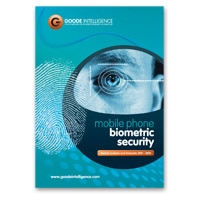“The conditions are now right to create a strong market,” says Goode Intelligence which forecasts that the current global user base of four million mobile biometrics users will grow to 39 million by 2015.

Goode Intelligence has published a new report that investigates the market for incorporating biometrics into mobile phones in order to prove that a secure transaction being conducted on a handset is being performed by the device’s actual owner.
“Biometric technology in mobile phones has existed for over ten years but has struggled to establish itself in a suitable use case that results in significant adoption rates,” say the authors. “The conditions are now right to create a strong market and Goode Intelligence forecasts that the current global user base of four million users in 2011 is set to grow to 39 million users by 2015.”
The Mobile Phone Biometric Security report predicts that initial growth will come from two technology groups: The first is embedded mobile biometrics (EMB), including fingerprint sensors embedded by device manufacturers, and the second is third-factor authentication, where mobile biometrics are used in combination with other authentication solutions such as voice-based biometrics.
“There are an estimated 13 million mobile devices around the world that are already benefiting from embedded mobile biometrics in the form of fingerprint sensors,” says Alan Goode, the report’s author. “A significant number of these are being used in south-east Asia, particularly in Japan where consumers are benefiting from fingerprint-based biometric security to protect NFC payments at the physical point of sale.”
Goode believes that this model could be replicated elsewhere: “2011 is seen as a pivotal year in the adoption of mobile payments using NFC in the rest of the world and there is a strong possibility that the Japanese model of using mobile phone-based biometric security will be duplicated. It may not necessarily replace existing authentication methods, such as chip and pin, as the primary authentication method but could undoubtedly augment it in certain circumstances.”
Goode states in the report that there are indications that more device manufacturers are turning to embedded mobile biometrics to enhance security and differentiate their models in an ever-crowded market; “Motorola has been heavily marketing the security benefits of using biometrics (fingerprint sensor) to protect its enterprise-ready Android smartphone, the Atrix, and there are rumours circulating of voice recognition features in the next generation of Apple’s iPhone 5.
“We believe a biometric groundswell is building. The market is currently slow; but pressure is growing. The conditions are ripe for rapid change; for biometrics to move from an ‘interesting concept’ to a ‘must have’ for all smart mobile devices.”
The report finds that the key drivers behind market growth and the adoption of mobile phone biometric security include mobile commerce applications and NFC as well as:
- Device security protection: Protecting the device against unauthorised access is the biggest driver for mobile phone biometric security. This includes protection both of apps and the data that resides on the device.
- A convenient alternative to PINs and passwords: Swiping a finger on a phone or providing a verbal ‘voiceprint’ can be an easier and far more convenient way to provide authentication than conventional technologies.
- As part of a multi-factor authentication solution: With the recent attack on RSA, leading to vulnerabilities being exposed in its SecurID token technology, there is a pressing need for strong and agile authentication solutions — mobile phone-based biometric security can be a viable part of this solution.
- Military and law enforcement: Mobiles can be a cost-effective method for capturing biometric data and verifying identity in the field.
Next: Visit the NFCW Expo to find new suppliers and solutions